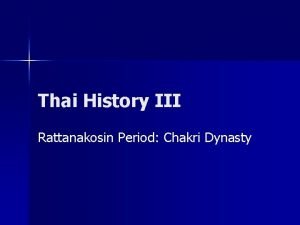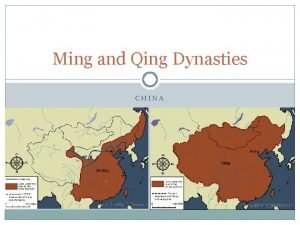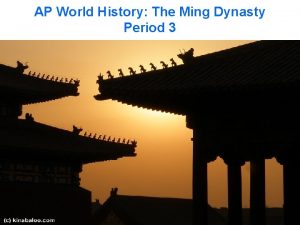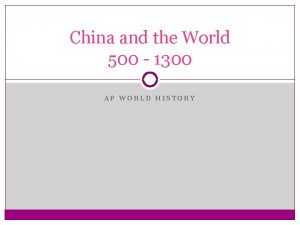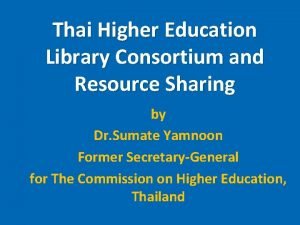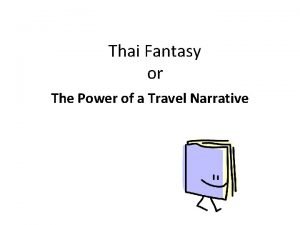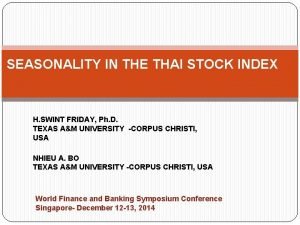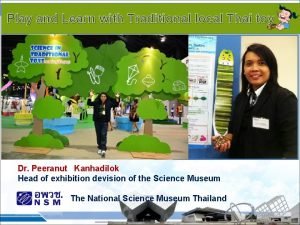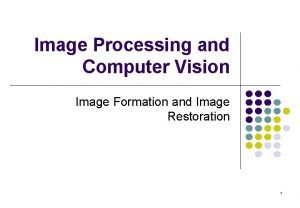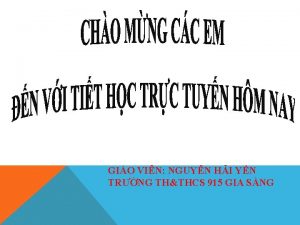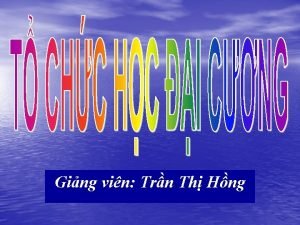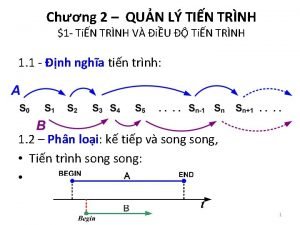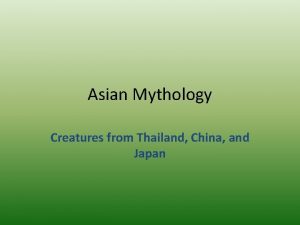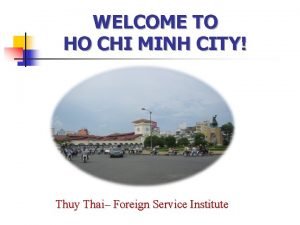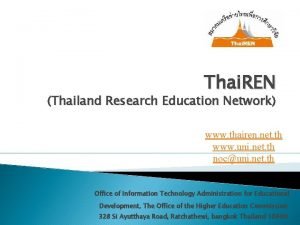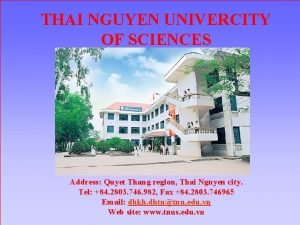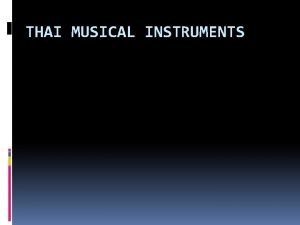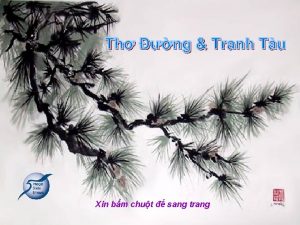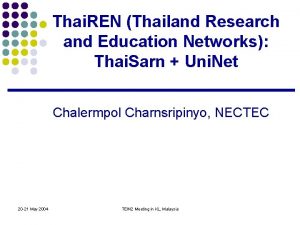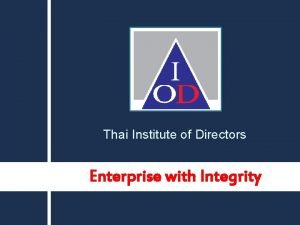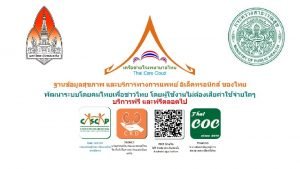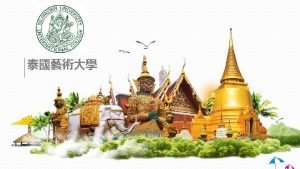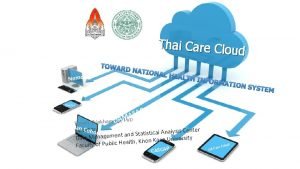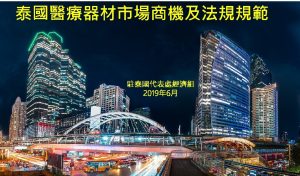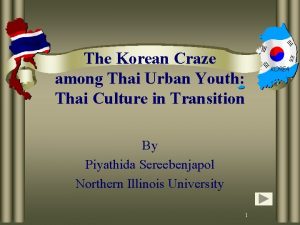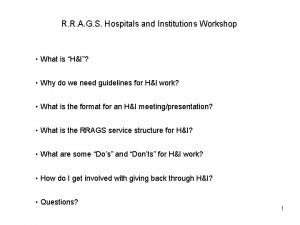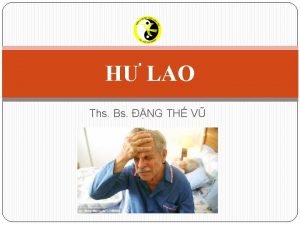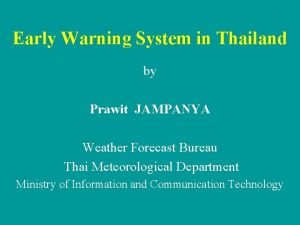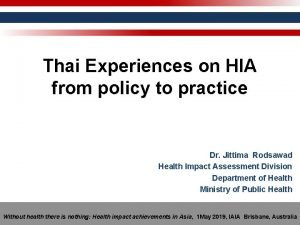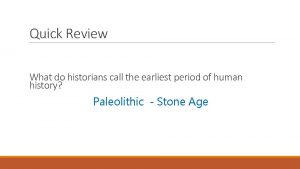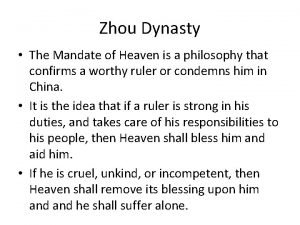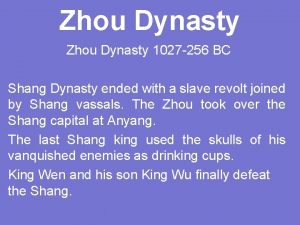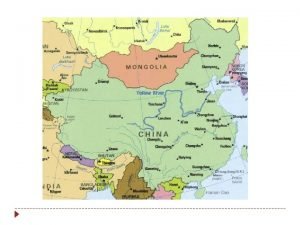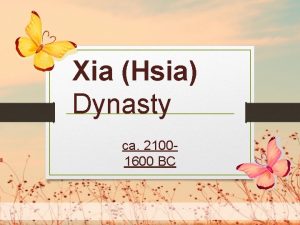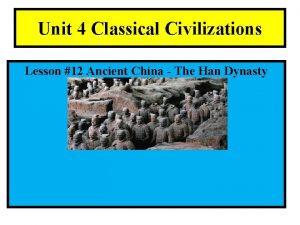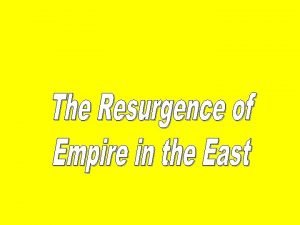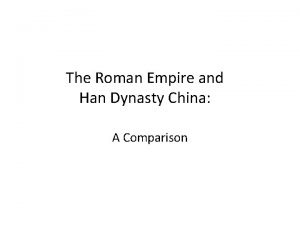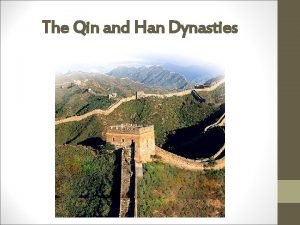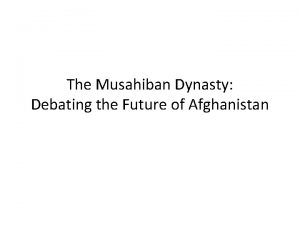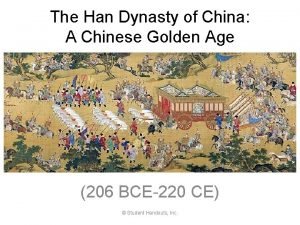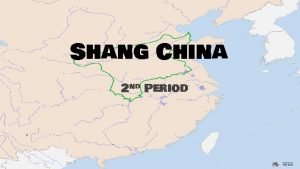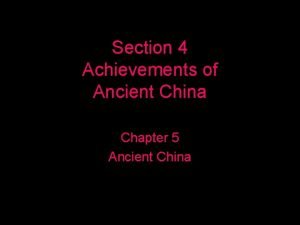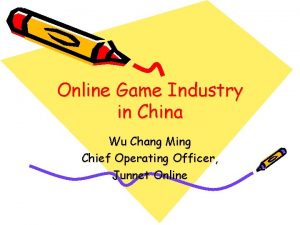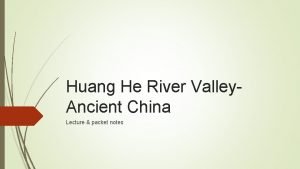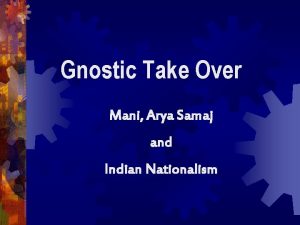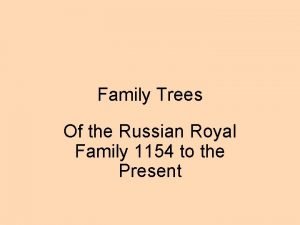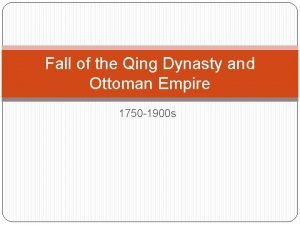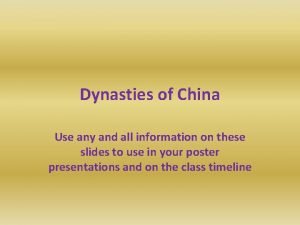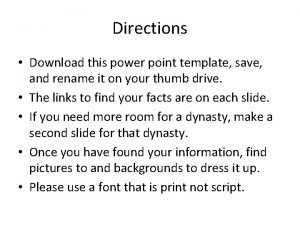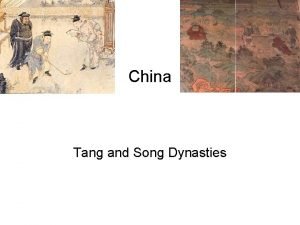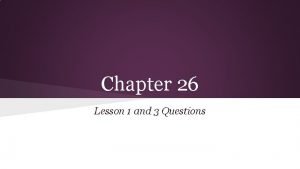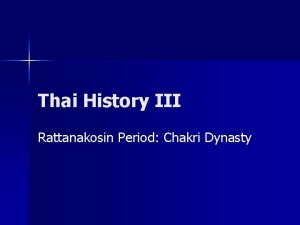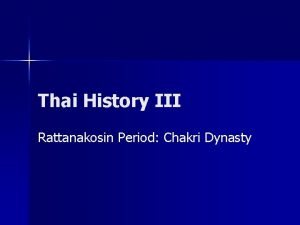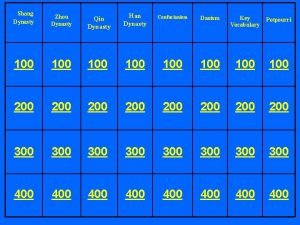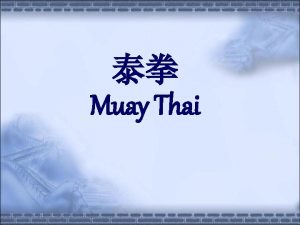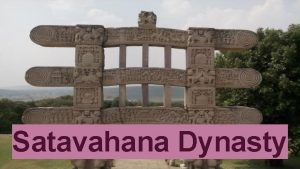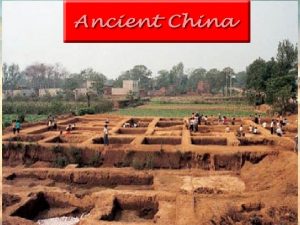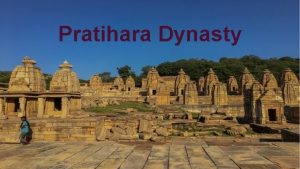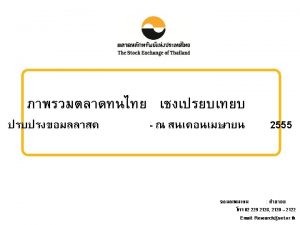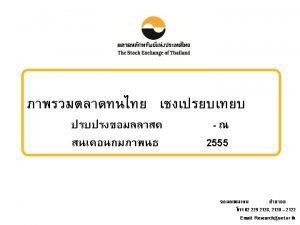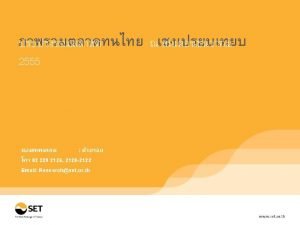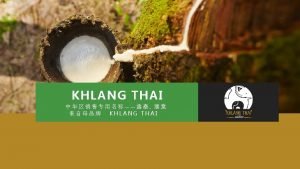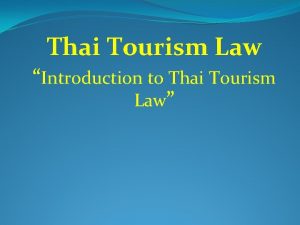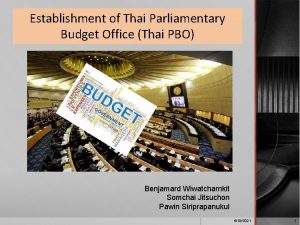Thai History III Rattanakosin Period Chakri Dynasty 9






































































































- Slides: 102

Thai History III Rattanakosin Period: Chakri Dynasty

9 Kings of Chakri Dynasty

9 Kings of Chakri Dynasty

Rattanakosin/Bangkok (since 1782) n When King Buddha Yod Fa Chulaloke, or King Rama I succeeded to the throne of Chakri dynasty, he and his younger brother started to establish Rattanakosin city or Bangkok in 1692. When the city was nearly completely found, most people both in Thonburi and Ayutthaya integrated to settle down in the new capital city.


Rama I (1782 - 1809) n Rama I (Buddha Yod Fah Chulaloke) became a king together with the inauguration of the Chakri dynastry on April 6, 1782. He moved the capital across the Chao Phaya River from Thonburi to "Bangkok”.

Restoration n He restored most of the social and political system of the Ayutthaya kingdom, promulgating new law codes, reinstating court ceremonies and imposing discipline on the Buddhist monkhood.

Occupation n In 1792 the Siamese occupied Luang Prabang and brought most of Laos under indirect Siamese rule. Cambodia was also effectively ruled by Siam. By the time of his death in 1809, Rama I had created a Siamese over lordship dominating an area considerably larger than modern Thailand.



Rama II (1809 - 1824) n In 1809, Rama II or King Buddha Loet Lah, son of Rama I took the throne until 1824. He devoted himself to preserve the Thai literature that had remained from Ayutthaya period and produced a new version of Ramakien or Thai Ramayana, the classical literature.

n The Chakri dynasty now controlled all branches of Siamese government — since Rama I had 42 children, and Rama II had 73, there was no shortage of royal princes to staff the bureaucracy, the army, the senior monkhood and the provincial governments. (Most children were of concubines and thus not eligible to inherit the throne. )

British Occupation n In 1785 the British occupied Penang, and in 1819 they founded Singapore. Soon the British displaced the Dutch and Portuguese as the main western economic and political influence in Siam. The British objected to the Siamese economic system, in which trading monopolies were held by royal princes and businesses were subject to arbitrary taxation.

British Demand n In 1821 the government of British India sent a mission to demand that Siam lift restrictions on free trade — the first sign of an issue which was to dominate 19 th century Siamese politics.

n Rama II died in 1824 and was succeeded by his son Prince Jessadabondindra, who reigned as King Nangklao, now known as Rama III. Rama II's younger son, Mongkut, was 'suggested' to become a monk, removing him from politics.


Rama III (1824 - 1851) n In 1824 -1851, Rama III or King Nang Klao was successful in re-establishing relation and making trades with China which was necessary to meet the increasing domestic agricultural production.

n In 1825 the British sent another mission to Bangkok led by East India Company emissary Henry Burney. They had by now annexed southern Burma and were thus Siam's neighbours to the west, and they were also extending their control over Malaya.

Burney Treaty n The King was reluctant to give in to British demands, but his advisors warned him that Siam would meet the same fate as Burma unless the British were accommodated. In 1826, therefore, Siam concluded its first commercial treaty with a western power, the Treaty of Amity and Commerce (Siam–UK) (also called the Burney Treaty).

Amendment of Monopolies n Under the treaty, Siam agreed to establish a uniform taxation system, to reduce taxes on foreign trade and to abolish some of the royal monopolies. As a result, Siam's trade increased rapidly, many more foreigners settled in Bangkok, and western cultural influences began to spread. The kingdom became wealthier and its army better armed.

British Trading with Siam

Bowring Treaty n In late Rama III, Siam used monopoly policy again that against the Burney Treaty. This resulted trading disputes between Siam and Britain. In 1855 (Rama IV), the British made Bowring treaty that forced Siamese to be under British trading at last.

Lao Rebellion n A Lao rebellion led by Anouvong was defeated in 1827, following which Siam destroyed Vientiane, carried out massive population transfers from Laos to the more securely held area of Isan, and divided the Lao Mueang into smaller units to prevent another uprising. In 1842– 1845 Siam waged a successful war with Vietnam, which tightened Siamese rule over Cambodia.

n By the 1840 s it was obvious that Siamese independence was in danger from the colonial powers: this was shown dramatically by the British First Opium War with China in 1839– 1842.

First Opium War

Foreign Traders’ Demands n In 1850 the British and Americans sent missions to Bangkok demanding the end of all restrictions on trade, the establishment of a western-style government and immunity for their citizens from Siamese law (extraterritoriality).

Chinese Influx n Economically, from its foundation, Rattanakosin witnessed the growing role of Chinese merchants, who were chased out before by king Taksin. Beside merchants, Chinese who were farmers, endlessly came to seek fortune in the new kingdom.

Chinese Assimilation n The Rattanakosin's rulers welcomed the Chinese, due to their source of economic revival. Some ethnic Chinese merchants became the court officials, holding crucial positions.

Relationship with China n Chinese culture such as literature was accepted and promoted. Many Chinese works were translated by ethnic Chinese court dignitaries. Siam's relationship with the Chinese Empire was strong.

It has been a royal tradition to build a temple of king since King Rama I. n Although temple of Rama III is Wat Ratcha O-Ros, his most visible legacy in Bangkok is the Wat Pho temple complex, which he enlarged and endowed with new temples. n Both temples contain many Chinese arts and sculptures. n

Wat Pho (Chetupon)

Chinese Guardians

Wat Ratcha-Oros

Chinese Arts@Thai temple


Rama IV (1851 - 1868) n Rama IV or King Mongkut (Phra Chom Klao), who reigned from 1851 to 1868 lived as a Buddhist monk for 27 years. He used his long sojourn as a monk to acquire a western education from French and American missionaries, and British merchants. He could speak many languages such as Latin, English, and five other languages.

n The missionaries hoped to convert him to Christianity, but in fact he was a strict Buddhist and a Siamese nationalist. He intended using this western knowledge to strengthen and modernise Siam when he came to the throne.

n Having been a monk for 27 years, he lacked a base among the powerful royal princes, and did not have a modern state apparatus to carry out his wishes. n His first attempts at reform, to establish a modern system of administration and to improve the status of debt-slaves and women, were frustrated.

n Under his reign, he created new laws to improve the women's and children's right. There was a common saying that “Woman is buffalo, Man is human”. n A Thai movie titled “Am Dang Muen and Nai Rid” portrayed women’s lives in this period.

Anna Leonowens

“Anna and the King” n Anna Leonowens, a British governess, presents a group of liberated Christian women in the 1800's that worked to end slavery. She was a part of Siamese history and has been fictionalized as The King and I. The film mentions that Anna was one of the forces that brought freedom from slavery and freedom of religion.

n Rama IV thus came to welcome western intrusion in Siam. Indeed the king himself was actively pro. British. This came in 1855 in the form of a mission led by the Governor of Hong Kong, Sir John Bowring, who arrived in Bangkok with demands for immediate changes, backed by the threat of force.

n The King readily agreed to his demand for a new treaty, called the Bowring Treaty, which restricted import duties to 3%, abolished royal trade monopolies, and granted extraterritoriality to British subjects. n Other western powers soon demanded and got similar concessions.

n The king soon came to consider that the real threat to Siam came from the French, not the British. The British were interested in commercial advantage, the French in building a colonial empire. They occupied Saigon in 1859, and 1867 established a protectorate over southern Vietnam and eastern Cambodia.

n Rama IV hoped that the British would defend Siam if he gave them the economic concessions they demanded. In the next reign this would prove to be mistaken, but it is true that the British saw Siam as a useful buffer state between British Burma and French Indochina.

Siam as Buffer State

Buddhist Affairs n Rama IV also adopted the discipline of local Mon monk as he saw many monks during that time were not so disciplined. Thus he founded a new sect in which called “Dhammayutika Nikaya”. This sect observed precepts stricter than the majority monks, later were called “Maha Nikaya”.


Rama V (1868 - 1910) n Rama V or King Chulalongkorn, Rama IV's son, continued the throne when he was 15 years old. Rama V was the first Siamese king to have a full western education.

Survival of Colonization n In 1886, Siam lost some territory to French, Laos and British Burma accorded the foreign powers intercede. After that King Chulalongkorn declared Thailand as an independent kingdom on the 23 rd of October.

n In 1893 the French authorities in Indochina used a minor border dispute to provoke a crisis. French gunboats appeared at Bangkok, and demanded the cession of Lao territories east of the Mekong.

Seize of Bangkok

n The King appealed to the British, but the British minister told the King to settle on whatever terms he could get, and he had no choice but to comply.

n Britain's only gesture was an agreement with France guaranteeing the integrity of the rest of Siam. In exchange, Siam had to give up its claim to the Tai-speaking Shan region of north-eastern Burma to the British.

n The French, however, continued to pressure Siam, and in 1906– 1907 they manufactured another crisis. This time Siam had to concede French control of territory on the west bank of the Mekong opposite Luang Prabang and around Champasak in southern Laos, as well as western Cambodia.

n The British interceded to prevent more French bullying of Siam, but their price, in 1909 was the acceptance of British sovereignty over of Kedah, Kelantan, Perlis and Terengganu under Anglo. Siamese Treaty of 1909.

n All of these "lost territories" were on the fringes of the Siamese sphere of influence and had never been securely under their control, but being compelled to abandon all claim to them was a substantial humiliation to both king and country.

n David K. Wyatt describes King Chulalongkorn as "broken in spirit and health" following the 1893 crisis and is the basis for the change in the name of the country; with the loss of these territories Great Siam was now no more, the king now ruled only the core Thai lands.

Nationalism n In the early 20 th century these crises were adopted by the increasingly nationalist government as symbols of the need for the country to assert itself against the West and its neighbors.

n Meanwhile, reform continued apace transforming an absolute monarchy based on relationships of power into a modern, centralized nation state. n The process was increasingly under the control of Rama V's sons, who were all educated in Europe.

n Railways and telegraph lines united the previously remote and semi-autonomous provinces. n The currency was tied to the gold standard and a modern system of taxation replaced the arbitrary exactions and labor service of the past.

Tradition Reforms n Rama V started to reform the tradition, legal and administrative realm by allowing officials to sit on chairs during royal audiences. Under the reign of Rama V, Thailand developed relations with European nations and the USA.

King Chulalongkorn n He introduced schools, roads, railways, and Thailand's first post office. He even established civil service system. n In 1892, Rama V overhauled the administration of Siam to a form of cabinet government with 12 ministers.

n The biggest problem was the shortage of trained civil servants, and many foreigners had to be employed until new schools could be built and Siamese graduates produced. By 1910, when the King died, Siam had become at least a semi-modern country, and continued to escape colonial rule.

VDO n Lands of Thailand


Rama VI (1910 - 1925) n Rama VI or King Vajiravudh, took the throne from 1910 to 1925. During his short reign, he introduced the Westernization to Thailand.

n He introduced the primary school education. n Thai women were encouraged to grow their hair at a certain length. n Surnames were introduced n Football was introduced in Thailand.

Thai women and girls in Early Ratttanakosin Period

Costumes for Thai Women

Western Education n He had been educated in Britain. Indeed one of Siam's problems was the widening gap between the westernised royal family and upper aristocracy and the rest of the country. It took another 20 years for western education to extend to the rest of the bureaucracy and the army: a potential source of conflict.

n King Vajiravudh, knew that the rest of the 'new' nation could not be excluded from government forever, but he had no faith in western-style democracy. He applied his observation of the success of the British monarchy in ruling of India, appearing more in public and instituting more royal ceremonies.

n However Rama VI also carried on his father's modernisation plan. Polygamy was abolished, primary education made compulsory, and in 1916 higher education came to Siam with the founding of Chulalongkorn University, which in time became the seedbed of a new Siamese intelligentsia.

n Bangkok became more and more the capital of the new nation of Siam. Rama VI's government began several 'nation-wide' development projects, despite the financial hardship. New roads, bridges, railways, hospitals and schools mushroomed throughout the country with national budget from Bangkok.

n King Vajiravudh's style of government differed from that of his father. In the beginning of the sixth reign, the king continued to use his father's team and there was no sudden break in the daily routine of government. Much of the running of daily affairs was therefore in the hands of experienced and competent men.

n Because of them, Siam owed many progressive steps, such as the development of a national plan for the education of the whole populace, the setting up of clinics where free vaccination was given against smallpox, and the continuing expansion of railways.

n However, senior posts were gradually filled with members of the King's coterie when a vacancy occurred through death, retirement, or resignation. By 1915, half the cabinet consisted of new faces.

World War I n In 1917 Siam declared war on German Empire and Austria-Hungary, mainly to gain favour with the British and the French. Siam's token participation in World War I secured it a seat at the Versailles Peace Conference.

n Foreign. Minister Devawongse used this opportunity to argue for the repeal of the 19 th century treaties and the restoration of full Siamese sovereignty. The United States obliged in 1920, while France and Britain delayed until 1925.

Post World War I n This victory gained the king some popularity, but it was soon undercut by discontent over other issues, such as his extravagance, which became more noticeable when a sharp postwar recession hit Siam in 1919.

Patriarchy n There was also the fact that the king had no son. He also obviously preferred the company of men to women (a matter which of itself did not much concern Siamese opinion, but which did undermine the stability of the monarchy because of the absence of heirs).

Transition n When Rama VI died suddenly in 1925, aged only 44, the monarchy was already in a weakened state. He was succeeded by his younger brother Prajadhipok.


Rama VII (1925 – 1935) n Rama VII or King Prachadhipok was Rama VI's brother. He changed Siam's form of government from absolute monarchy to democracy. This revolution developed the constitutional monarchy along British lines, with mixed military and civilian group in power.

n Unlike his predecessor, the king diligently read virtually all state papers from ministerial submissions to petitions by citizens. Within half a year only one fourth of Vajiravhud's ministers stayed on, the rest having been replaced by members of the royal family. On the one hand, these appointments brought back men of talent and experience, on the other, it signaled a return to royal oligarchy.

n The initial legacy that Prajadhipok received from his elder brother were problems of economy: the finances of the state were in chaos, the budget heavily in deficit, and the royal accounts an accountant's nightmare of debts and questionable transactions. Other countries were deep in the Great Depression following World War I did not help the situation either.

n The first act of Prajadipok as king entailed an institutional innovation intended to restore confidence in the monarchy and government, the creation of the Supreme Council of the State.

n This privy council was made up of a number of experienced and extremely competent members of the royal family, including the long time Minister of the Interior (and Chulalongkorn's right-hand man) Prince Damrong.

n Gradually these princes arrogated increasing power by monopolising all the main ministerial positions. Many of them felt it their duty to make amends for the mistakes of the previous reign, but it was not generally appreciated.

n With the help of this council, the king managed to restore stability to the economy, although at a price of making a significant amount of the civil servants redundant and cutting the salary of those that remained. This was obviously unpopular among the officials, and was one of the trigger events for the coup of 1932.

n Prajadhipok then turned his attention to the question of future politics in Siam. Inspired by the British example, the King wanted to allow the common people to have a say in the country's affair by the creation of a parliament.

n A proposed constitution was ordered to be drafted, but the King's wishes were rejected by his advisers, who felt that the population was not yet ready for democracy.

n In 1932, with the country deep in depression, the Supreme Council opted to introduce cuts in official spending, including the military budget. The King foresaw that these policies might create discontent, especially in the army, and he therefore convened a special meeting of officials to explain why the cuts were necessary.

n Serious political disturbances were threatened in the capital, and in April the king agreed to introduce a constitution under which he would share power with a prime minister. This was not enough for the radical elements in the army, however.

1932 Coup n On June 24, 1932, while the king was holidaying at the seaside, the Bangkok garrison mutinied and seized power, led by a group of 49 officers known as "the Promoters". Thus ended 150 years of Siamese absolute monarchy.

General Phibul Songkhram n At that time, Phibul Songkhram was a key military leader in the 1932 coup. He maintained his position and power from 1938 until the end of World War II.


Rama VIII (1935 – 1946) n Rama VIII or King Ananda Mahidol, a nephew of Rama VII, took the throne in 1935 but was assassinated under mysterious circumstances in 1946. His brother King Bhumipol Aduldej succeeded as Rama IX.


Rama IX (Since 1946) n Under Rama IX's government, the country's name was officially changed from "Siam" to "Thailand" in 1946 which was defined in Thai as "Prathet Thai", the word "Prathet" means "country" and the word "Thai" means "free" referring to the Thai races.

VDO n Correction: Land of Thailand

Assignments n Select 1 essay from the book “Essays on Thailand” to present on Thursday 13 th of June. (10 points)
 Rattanakosin dynasty
Rattanakosin dynasty Hamlet act iii scene iii
Hamlet act iii scene iii Ming and qing dynasty
Ming and qing dynasty Sui tang and song dynasties
Sui tang and song dynasties Ming dynasty ap world history
Ming dynasty ap world history Sui dynasty definition ap world history
Sui dynasty definition ap world history Critical period vs sensitive period
Critical period vs sensitive period A&p flix activity: resting membrane potential
A&p flix activity: resting membrane potential Is hyperpolarization the same as refractory period
Is hyperpolarization the same as refractory period Critical period vs sensitive period
Critical period vs sensitive period Critical period vs sensitive period
Critical period vs sensitive period Approaches to child development
Approaches to child development Classic period
Classic period Non metal halogen
Non metal halogen The period of activism in philippine literature
The period of activism in philippine literature Stability period vs measurement period
Stability period vs measurement period Trustee period and royal period
Trustee period and royal period Paleolithic age time period
Paleolithic age time period Thai lorem ipsum
Thai lorem ipsum Thai digital collection
Thai digital collection Thai fantasy
Thai fantasy Coc database
Coc database Thai stock market set index series
Thai stock market set index series Thai toys
Thai toys Computer graphic
Computer graphic Môi trường sống và các nhân tố sinh thái
Môi trường sống và các nhân tố sinh thái 5 hình thái kinh tế xã hội
5 hình thái kinh tế xã hội Biến thái hoàn toàn
Biến thái hoàn toàn Các trạng thái của tiến trình
Các trạng thái của tiến trình Thai dragon mythology
Thai dragon mythology Nêu ưu điểm của sự thai sinh
Nêu ưu điểm của sự thai sinh Thuy thai
Thuy thai Ren thailand
Ren thailand Thai popular songs
Thai popular songs Flowers
Flowers Khrueang sai instrument
Khrueang sai instrument Amin thai
Amin thai độc tọa u hoàng lý
độc tọa u hoàng lý Hình ảnh chế độ a pác thai
Hình ảnh chế độ a pác thai Thai traditional dessert
Thai traditional dessert Ren thailand
Ren thailand Thai institute of directors association
Thai institute of directors association Esportes
Esportes Upas lc flow chart
Upas lc flow chart Thaicarecloud
Thaicarecloud định luật hess và hệ quả
định luật hess và hệ quả Thai language
Thai language Thai care cloud
Thai care cloud Dmht thailand
Dmht thailand K boxing china
K boxing china Fire resistant cable thai yazaki
Fire resistant cable thai yazaki Nap thai
Nap thai Language thai
Language thai Diễn thế sinh thái là
Diễn thế sinh thái là Thai singer clip
Thai singer clip H&i express thai
H&i express thai Thái xung huyệt
Thái xung huyệt Satellite radar
Satellite radar Poslopja na kmetiji
Poslopja na kmetiji Thai buddhist wedding
Thai buddhist wedding Thailand franchise association
Thailand franchise association Ap world history 600 to 1450 review
Ap world history 600 to 1450 review Egypt floral design
Egypt floral design Mechanical .
Mechanical . Neanderathal
Neanderathal What do historians call the early period of human history
What do historians call the early period of human history Ap world history period 2 test
Ap world history period 2 test History also history physical
History also history physical Mandate of heaven zhou dynasty
Mandate of heaven zhou dynasty Zhou dynasty achievements
Zhou dynasty achievements Shang dynasty map
Shang dynasty map Xia (hsia) dynasty
Xia (hsia) dynasty Hannover dynasty
Hannover dynasty Welcome 1 unit 6 lesson 3
Welcome 1 unit 6 lesson 3 Social classes in the han dynasty
Social classes in the han dynasty Song dynasty social structure
Song dynasty social structure Roman empire china
Roman empire china China qin dynasty map
China qin dynasty map Habibullah kalakani
Habibullah kalakani Han dynasty bureaucracy
Han dynasty bureaucracy Chinese dynasty acrostic poem
Chinese dynasty acrostic poem What is a dynasty trust
What is a dynasty trust Han sui tang song
Han sui tang song Dar al islam spice chart
Dar al islam spice chart Shang dynasty jobs
Shang dynasty jobs Achievements of ancient china
Achievements of ancient china Ming dynasty game online
Ming dynasty game online Qing dynasty location
Qing dynasty location Conclusion of delhi
Conclusion of delhi Aryan dynasty
Aryan dynasty Hovanho civilization
Hovanho civilization Villarvattom dynasty
Villarvattom dynasty Catherine the great illegitimate child
Catherine the great illegitimate child The rise and fall of qing dynasty
The rise and fall of qing dynasty Difference between empire and dynasty
Difference between empire and dynasty English renaissance time period
English renaissance time period The wing dynasty
The wing dynasty Xia dynasty government
Xia dynasty government Facts about the qin dynasty
Facts about the qin dynasty How did the qing dynasty fall
How did the qing dynasty fall Golden ages of china tang and song dynasties
Golden ages of china tang and song dynasties Tang dynasty map
Tang dynasty map Chapter 26 lesson 1 the decline of the qing dynasty
Chapter 26 lesson 1 the decline of the qing dynasty
